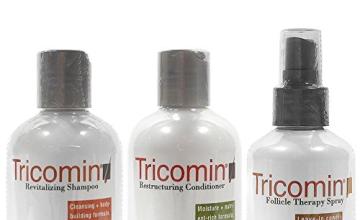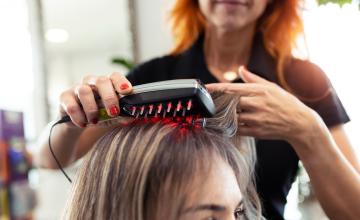Dr. Christian Bisanga






Tricomin is an all natural hair loss treatment designed for both men and women with thinning hair to stimulate hair regrowth and improve the appearance of thinning hair. It can also be used in conjunction with with Rogainehair regrowth treatment.
Tricomin Solution Follicle Therapy Spray combines the benefits of the Triamino Copper Nutritional Complex with an exceptional leave-in conditioner. The therapy spray enriches your hair and scalp with a unique blend of mineral and body-building ingredients and essential amino acids. Spraying the therapy spray liberally after shampooing daily will condition and treat your hair and scalp. It's recommended to apply this product to damp or dry hair.
The Tricomin Revitalizing Shampoo stimulates and restores health, structure, and vitality to thinning, fine, and damaged hair. It's recommended to use the Revitalizing Shampoo daily, gently massaging it into moistened hair scalp, leaving on for 3 to 5 minutes before rinsing. A second application may be made if desired.
The Restructuring Conditioner uses a unique moisture and nutrient-rich framework to help restore your hair's natural mineral and protein balance. This conditioner helps to add structure and body onto thinning and/or damaged hair.
For best results, use all three Tricomin products in conjunction with one another. All 3 Tricomin products is called the Tricomin TricoPak.
Al three Tricomin products contain the active ingredient copper peptides. Scientific evidence suggests that copper peptides can shorten the shedding (telogen) phase and elongate the growth (anagen) phase of the follicles. Partial FDA trials showed Tricomin products' effectiveness in promoting new hair growth.
Tricomin copper peptide technology may provide marginal benefit to men and women with thinning hair. To date, only surgical hair restoration is proven to grow hair in completely bald areas. You are invited to have a free virtual consultation with one of our prescreened hair restoration physicians.
Tricomin Follicle Therapy Spray: Purified Water, SD Alcohol 40B, Amodimethicone, Nonoxynol-10, Panthenol, Polyquaternium-11, Polysorbate 60, Tallowtrimonium Chloride, Citric Acid, Dimethyl Lauramine Isostearate, Linoleamidopropyl Ethyl Dimonium Ethosulfate, Triamino Copper Nutritional Complex (Alanine/Histidine/Lysine Polypetide Copper HCl), Methylparaben, Benzethonium Chloride, Menthol, FD&C Blue #1.
Tricomin Revitalizing Shampoo: Purified Water, Sodium Laureth Sulfate, Disodium Cocoamphodiacetate, Cocomidopropyl Betaine, Ceteth-16, Glycerin, Laneth-16, Oleth-16, Steareth-16, PEG-75 Lanolin, Sodium Chloride, Triamino Copper Nutritional Complex (Alanine/Histidine/Lysine Polypetide Copper HCl), Citric Acid, Diazolidinyl Urea, Hydrolyzed Keratin, Panthenol, Methylparaben, Fragrance, Propylparaben, Peppermint Oil, D&C Red #33, FD&C Blue #1.
Tricomin Restructuring Conditioner: Purified Water, Glyceryl Stearate, PEG-100 Stearate, Stearamidopropyl Dimethylamine, Cetyl Alcohol, Propylene Glycol, Stearyl Alcohol, Dimethylamine, Triamino Copper Nutritional Complex (Alanine/Histidine/Lysine Polypetide Copper HCl), Hydroxyethylcellulose, Panthenol, Aloe Vera Gel, Soydimonium Hydroxypropyl Hydroxylyzed Wheat Protein, Hydroxylyzed Keratin, Citric Acid, Methylparaben, Fragrance, Disodium EDTA, Propylparaben, Peppermint Oil, Tocopheryl Acetate, Cholecalciferol, Retinyl Palmitate, Vegetable Oil, FD&C Blue #1, D&C Red #33.

Use of low level laser therapy (LLLT) devices for treating hair loss has been heavily debated for some time by reputable hair restoration physicians and patients on our hair loss forum. While some physicians reject its use entirely, others use laser hair treatment as a regular part of their practice. Additionally, some physicians believe that laser light therapy can assist with postoperative healing after hair transplant surgery.
Shortly after the first working laser was invented in 1964, a researcher from Semmelweis University of Budapest named Andre Mester developed a theory that exposure to cold laser light (similar to UV radiation emitted by the sun) may eventually lead to cancer. To test his theory, Mester shaved a group of mice and trapped some of them in a cage with constant cold laser light exposure leaving the other half unexposed as a control group. To his surprise, the light didn’t cause cancer in any of his animal subjects. Instead, mice that were exposed to the laser light therapy grew back their shaved fur much faster than the control group. Mester named his discovery photo-biostimulation. His theory was that somehow, the laser light had stimulated the hair cells into an accelerated state of hair growth.
Today, low level laser therapy is being used as a hair loss treatment. To treat baldness with laser light therapy, laser rays are directly applied to the scalp by a mechanical device so that red blood cells are stimulated. Lasers are said to work by converting ATP (Adenosine Triphosphate) to ADP (Adenosine Diphosphate), releasing energy and causing cellular metabolic changes. During this process, additional nutrients and oxygen are provided to the scalp assisting the normal chemical processes performed by those cells, increasing overall blood circulation. Lasers, when applied to the scalp and hair, have been said to improve overall hair quality, promote hair growth, and increase hair shaft diameter.
Laser treatment devices have a similar appearance to a hood hair dryer which is placed over top of your head. The low level laser toll will rotate allowing laser rays, usually red in color, to be discharged into your scalp. Hand held devices such as the Hairmax comb have also been developed and resemble a brush in appearance.
Promoting healthy hair growth however, is not the same as the regrowth of miniaturized hairs brought on by genetic female hair loss or male pattern baldness (MPB). So what clinical evidence exists, if any, that laser therapy is an effective treatment? Below we take a closer look at the available data including exclusive interviews of leading hair restoration physicians.
Physicians have long shared varying views on whether or not laser treatment is viable. While some well respected physicians reject its use entirely, some believe that LLLT can provide marginal benefit for men and women suffering from androgenic alopecia (genetic baldness). Additionally, some physicians believe that laser hair treatment can assist a hair transplant patient’s postoperative wound healing process and expedite hair growth.
Dr. Charles (one of our well respected members of the Coalition of Independent Hair Restoration Physicians) believes it may provide similar hair loss prevention benefit to Rogaine in the mid vertex area and crown. Benefits in the frontal area include an increase in overall hair quality rather than hair loss prevention.
Dr. Charles believes LLLT works better when combined with Propecia (finasteride) and Rogaine (minoxidil). Like Propecia and Rogaine, he believes low level laser therapy may help some patients more than others and works better in patients with only minimal thinning hair.
Dr. Charles believes in helping balding men and women develop and maintain realistic expectations and he doesn’t oversell its benefits. Because lasers are free from side effects, he always tells his patients that the biggest risk is the money. Dr. Charles believes more research on laser hair treatment is needed.;
Dr. Williams of the Coalition has been using laser hair treatment as a regular part of his practice for over 2 years and feels quite confident in its success in some patients. In his experience, LLLT promotes healthy hair growth and can increase hair shaft diameter of miniaturized hair affected by genetic female hair loss and male pattern baldness in some patients.
Dr. Williams offers 16 free laser therapy sessions to local males following hair transplant procedures and encourages his female transplant patients to undergo laser light therapy for one full year at a highly discounted rate. Dr. Williams usually notices faster transplanted hair regrowth and a quicker resolution of postoperative telogen effluvium or “shock loss”, if it occurs.
Because androgenic alopecia is a progressive condition, Dr. Williams encourages male patients to use Propecia while encouraging out of town females to use the Hairmax laser comb to help maintain their existing hair. Dr. Williams would like to see more formal studies defining the benefits of lasers as a hair loss treatment, but he is encouraged by his experience with it to date.
Dr. Alan Feller (also a member of the Coalition) is one doctor who remains skeptical. "Medical lasers work in only one way, and that is to deliver energy to a target. When it strikes the target the energy is absorbed and converted to heat. That's it". Dr. Feller believes that more compelling evidence is needed to promote low level laser therapy (LLLT) as a hair regrowth solution or to stop hair loss.
study presented at the last International Society of Hair Restoration Surgery (ISHRS) meeting in Las Vegas (2007) by Maria A Muricy, MD, confirms increase in hair shaft diameter, fullness, and overall quality with laser hair treatment alone. Additionally, some statistically significant evidence reveals that low level laser therapy when combined with 5% minoxidil (the active ingredient in FDA approved Rogaine) provided noticeable cosmetic benefits for women in particular. However, this study also showed that laser hair loss treatment alone produced no statistically significant new hair growth in both men and women.
Another important issue to consider is the significance and meaning of the FDA clearance (not approval) of the Hairmax laser comb. Though some have proposed the Hairmax laser comb was only approved for safety, apparently the FDA did require Lexington International (who funded the study) to provide it with a study on its efficacy (effectiveness) in treating baldness. But this study and its results have not been released to the public since Lexington International had the option of submitting the study to the FDA privately. The obvious question then is – why would Lexington hide their study from the public if it proved the efficacy of laser hair regrowth?
While the Hairmax laser comb device was found by the FDA to be safe based on its “substantial equivalence” to previously approved laser light therapy devices and thus “cleared” (not “approved”), it was unclear to what extend the FDA reviewed or cleared it based on its effectiveness in treating hair loss. To learn more about the FDA standards for “approving” food and drugs and for “clearing” medical devices visit www.fda.gov
It appears that much of the laser hair treatment industry is now promoting their devices as “FDA Approved for Hair Loss” as if they are on par with the two only FDA approved hair loss solutions Propecia (finasteride) and Rogaine (minoxidil). However, until laser hair treatment provides compelling public evidence of its effectiveness in treating hair loss, it is quite possible that the effectiveness of low level laser therapy may be oversold by some companies. We expect that time will tell.


If you are going bald you should seriously consider hair loss medication treatments to halt or even reverse your hair loss. While there is no “Hair Loss Cure”, hair loss drugs like finasteride (Propecia) and dutasteride (Avodart) can often stop or even reverse alopecia areata in most people.
However, just like any other drug, Propecia is accompanied by a list of potential side effects, some of which have been more recently reported as potentially long term. You can read more about this in the "What About Side Effects" section further down this page.
Studies have shown that 80% of men using Propecia stopped or even reversed their hair loss to some degree. Preliminary clinical trials for Avodart appear even more effective than Propecia.
However, neither Propecia nor Avodart has been proven to restore hair in the frontal areas. For reasons yet unknown these drugs, along with Rogaine, only generally work in regrowing thinning hair in crown area of the scalp. Only hair transplant surgery has been successful in restoring hair in the frontal hairline area once it has been lost.
Propecia and Avodart are also less effective in growing hair in older men. These hair loss drugs work best for men who have been balding for less than five years.
Both Propecia and Avodart are not recommended for use by women or children.
It’s been found that these drugs can cause birth defects. More specifically, these birth defects may occur when large amounts of the drug are absorbed into the body during the period of foetal development.
Physicians advise pregnant women to not handle Propecia tablets, as this may harm male foetuses. But as of yet, there has not been a single reported case of birth defects caused by handling these tablets.
Furthermore, there’s also no evidence that pregnant women exposed to the semen of Propecia or Avodart patients will risk any birth defects.
Propecia and Avodart are also not advisable for men with liver disease or prostate cancer.
Often our member physicians will prescribe Propecia or Avodart to halt a patient’s hair loss and then restore the hair already lost with hair transplant surgery. These treatments in combination can work synergistically. The drugs work to halt the hair loss, while hair restoration surgery restores what was lost.
To get a prescription for Propecia or Avodart schedule a free no obligation consultation with any of our quality hair restoration physicians. Find a physician in your area.
Propecia and Avodart should be taken once a day. It has been found that after two years of treatment, Propecia effectively grows hair in about 66% of patients. Also, about 83% of the subjects receiving this treatment continue to maintain their existing hair after two years.
Propecia (Finasteride) was originally a drug called Proscar, which was used to treat and reduce men's prostate conditions such as benign prostatic hyperplasia (BPH).
Its parent company, Merck & Co., soon realized that the drug had a unique side effect - it grew hair on bald men's heads.
In December 22, 1997 the FDA approved Propecia as a hair loss pill. Merck & Co. then marketed the drug as a hair loss treatment under the trade name of Propecia.
More recently Dutasteride, sold as Avodart, has generated interest as a promising new hair loss medication. Like finasteride (Propecia) it inhibits the creation of DHT and was originally developed as a treatment for men’s prostate condition.
However, unlike Propecia, Avodart inhibits the creation of both type one and type two 5 alpha reductase enzymes. Dutasteride has been shown to decrease levels of DHT by 90% after only two weeks, making it a more powerful and faster acting weapon against hair loss than Propecia (Finasteride).
Dutasteride is not yet FDA approved for the treatment of hair loss. However, some hair restoration physicians also prescribe it for the treatment of hair loss. Like Propecia, Avodart is not safe for women and children.
Losing your hair took time. So too will regrowing your hair using Propecia or Avodart. These drugs require patients to take the drug daily for at least three months before any obvious changes will be noticeable. Most physicians advise taking these drugs for a year before evaluating their effectiveness.
At this time, Propecia and Avodart are only available by prescription. Our member physicians are available to discuss these hair loss drugs with you and prescribe them if appropriate. To find a quality hair restoration physician in your area.
Aside from Propecia and Dutasteride, there are other treatment options (all topical) that may or may not work to block the effects of DHT on vulnerable hair follicles. These include Revivogen, Crinagen, Progesterone Creams, and Xandrox (a type of minoxidil). Other DHT Blockers
To learn more about these treatments, as well as all other topical options, visit our Topical Hair Loss Products and Treatments section.
Baldness is largely the result of dihydrotestosterone (DHT) interacting with those hair follicles that are genetically vulnerable to their effects.
DHT is essentially the active ingredient or catalyst for the hair loss process. DHT binds with the receptor sites of genetically vulnerable follicles and gradually degrades the follicles ability to produce healthy hair. This eventually results in baldness in the affected areas.
Hair loss drugs like Propecia or Avodart work by inhibiting the conversion of testosterone into dihydrotestosterone (DHT). By reducing the amount of DHT present in the scalp the hair loss process is slowed and in some cases even reversed.
Up until a couple of years ago, side effects when taking Propecia or Avodart were only considered temporary. However, over the last several years, many me have reported ongoing side effects from Propecia even after stopping treatment. This more permanent condition has become known as "Post Finasteride Syndrome" or (PFS). Side effects included but aren't limited to reduced semen production, a reduced libido and softer erections.
As a result, in April of 2012, the FDA mandated labeling changes to finasteride related products. Labeling changes to Propecia include "libido disorders, ejaculation disorders, and orgasm disorders that continued after discontinuation of the drug". Labeling changes to Proscar include "decreased libido that continued after discontinuation of the drug". Labeling changes to both Propecia and Proscar include "reports of male infertility and/or poor semen quality that normalized or improved after drug discontinuation".
While most men don't experience any side effects at all, it should be known that a small percentage of men may experience persistent side effects even after stopping treatment. Most men who experience side effects however, only experience them temporarily and stopping treatment makes them go away.
For a list of potential side effects and more information on Post Finasteride Syndrome", visit http://www.pfsfoundation.org/.

Viviscal's hair growth vitamin and dietary supplement taken twice daily promises to "reverse hair loss" and grow thicker hair in both men and women experiencing balding and thinning hair. Its primary activeingredient, AminoMar C™ Marine Complex, is said to be a proprietary blend of ingredients and proteins that "provides the essential nutrients needed to nourish thinning hair and promote existing hair growth".
The entire Viviscal product line includes an "all natural" dietary supplement, a shampoo and conditioner, and a scalp lotion. Viviscal is promoted as being 100% natural, drug-free, gluten-free and safe from harmful side effects. But can Viviscal deliver on its promises to reverse hair loss and grow new hair?
In 2011, Viviscal advertisement was banned in the United Kingdom by the Advertising Standard Authority (ASA) who deemed that its claims to maintain optimum hair health were unproven. The ASA concluded:
"Because the evidence sent did not show that the ingredients in Viviscal had been shown to have a positive effect on hair health, we concluded the claims that the product could 'nourish hair follicles' had not been substantiated' and ruled the advert cannot be broadcast until it is changed."
However, as with many similar products promising to grow hair, substantiating their hair growth claims may not be a simple task.
Viviscal’s manufacturer does reference a number of studies that seem to support their claims of growing thicker hair. For example, the results of "Scientific Pilot Study #1" on 40 hair loss suffering females with an average age of 35 concluded, "Viviscal was well received by test subjects and the analysis of hair counts showed a mean reduction in hair loss of 46% in only 10 weeks." Additional studies are cited on Viviscal’s website.
Recently, we learned that Dr. Glenn Charleshas publicly endorsed Viviscal. Dr. Charles has an outstanding reputation for performing state of the art hair transplant surgery and is a highly esteemed member of the Coalition of Independent Hair Restoration Physicians.When asked to comment on his public endorsement of Viviscal, Dr. Charles stated:
"I have never had any hair loss patients display any negative effects. I describe it to my patients as a natural supplement that can promote a healthier scalp and hair. It may also, in turn, slow down the hair loss process. I tell all my patients that there are no guarantees with this product. Although most patients believe that they did have improvement after using this product, I admit that some patients do not see any noticeable changes that either they or I can identify."
Other hair loss experts are not as optimistic regarding Viviscal’s hair growth potential. Coalition member Dr. Bill Rassmanof Los Angeles states:
"I am skeptical of the photographs (results) and the changes shown make me doubt what the Viviscal marketing department wants me to see. Viviscal reportedly contains ‘special marine extracts and a silica compound’ - and yet I’m to believe this will regrow hair? If these photos were real, the product would have taken over the market years ago."
It's also important to note that Viviscal does notmake any claims on their website that their products can reverse the effects of genetic hair loss. Instead, it simply states, "Viviscal works to reverse hair loss due to stress, poor nutrition, and many health related ailments".
So is Viviscal an effective hair loss treatment? More research may be needed before this question can be effectively answered.
While there may be no harm (potential side effects) in trying it, at an average cost of $600 per year there are certainly more affordable and proven treatments available. The only clinically proven and FDA approved medical hair loss treatments currently available are Rogaine (minoxidil) and Propecia (finasteride). While Rogaine may be used by both male and female patients, Propecia is safe and approved only for male hair loss sufferers. Always consult your physician before adding any treatment to your hair loss regimen.

 Crinagen is an all natural alcohol-free topical scalp spray clinically backed to reduce the amount of DHT (dehydrotestosterone) in the scalp. It contains no alcohol, and has displayed no side effects. Crinagen is also equally safe for men and women and is most effective in men and women with thinning hair. In addition to blocking scalp DHT, they both are reported nourish the scalp’s hair follicles. Crinagen usually displays its effects on average in five months.
Crinagen is an all natural alcohol-free topical scalp spray clinically backed to reduce the amount of DHT (dehydrotestosterone) in the scalp. It contains no alcohol, and has displayed no side effects. Crinagen is also equally safe for men and women and is most effective in men and women with thinning hair. In addition to blocking scalp DHT, they both are reported nourish the scalp’s hair follicles. Crinagen usually displays its effects on average in five months.
The product's main ingredients are Saw Palmetto, Zinc, and Azelaic Acid. All 3 ingredients are reported to reduce the production of scalp DHT and nourish the scalp's hair follicles.
Crinagen has not been clinically proven nor approved by the FDA. Thus, like Revivogen and Tricomin, Crinagen should be used only after seriously considering proven treatments like Propecia (finasteride) and Rogaine (minoxidil).
Don't expect immediate results. It's recommended to use Crinagen for at least 6 to 12 months before determining its effectiveness. Documenting your progress with bi-monthly photos can help you determine whether or not Crinagen is working for you.
Hair shedding is a common symptom the first few months and a sign that the medication may be working for you. It's crucial to push past this stage with continued use for the recommended period of time.
To date, only surgical hair restoration is proven to grow hair in completely bald areas. You are invited to have a free virtual consultation with one of our prescreened hair restoration physicians.

Unlike male pattern baldness (MPB) and female pattern hair loss (FPHL), which tends to follow one of the hair loss patterns defined by the NorwoodScale and the LudwigScale, Diffuse Patterned Alopecia (DPA) is characterized by diffuse thinning throughout the front, crown and vertex(crown) with no distinct pattern evident. However, like male and female pattern balding,Diffuse Patterned Alopecia patients typically preserve the stable "permanent zone" on the sides and back of the scalp and may sometimes retain a well-defined hairline. DPA is also a type of hereditary balding condition like and rogenetic alopecia (genetic hair loss).
Diffuse Patterned Alopecia (DPA) can be difficult to diagnose and, particularly in its early stages, may be confused with a similar condition known as Diffused Unpatterned Alopecia (DUPA). While both conditions are characterized by diffuse thinning, DUPA sufferers lack the stable permanent zone necessary for surgical hair restoration.
DPA often responds well to medical hair loss treatments like Propecia (finasteride) and Rogaine(minoxidil) and, due to the preservation of the permanent donor region, many DPA sufferers are candidates for hairrestoration surgery.
It’s essential that hair loss suffering men and women seeking medical and/or surgical treatment for diffuse thinning consult with a skilled and experienced hair restoration physician. Differentiating between DPA and DUPA is critical because Diffuse Patterned Alopecia patients frequently make good hair transplant candidates, whereas DUPA patients rarely do.